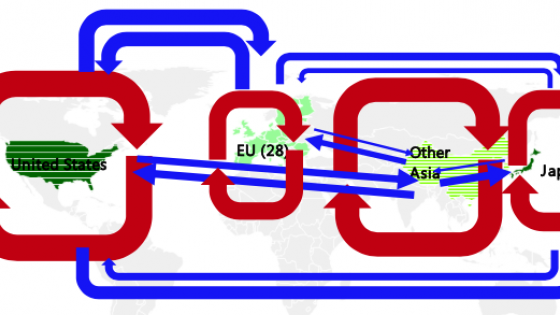The patent system is built on a grand bargain: in exchange for exclusive rights over their inventions, inventors are required to disclose their ‘secret sauce’ to the public. Most studies of patents consider the benefits and costs of exclusivity, but we know little about the other side of the bargain (see Hall et al. 2014 and Williams 2017 for excellent surveys of research on patents). And what little we know about patent disclosure is contentious. Some studies suggest that disclosure benefits inventors (e.g. Hegde and Luo 2018, Furman et al. 2021) and generates significant knowledge flows across countries (e.g. Eugster et al. 2019 , Smeets and de Vaal 2011), while others argue that “patent disclosures play an insignificant role in promoting R&D spillovers” (Roin 2005).
It is challenging to convincingly measure the effect of patent publication on innovation and economic growth. For example, patent publication in the US historically occurred simultaneously with a patent grant, making it hard to tease apart their distinct effects on follow-on invention. Yet, anecdotally it appears that the information disclosed in patents is important for technological progress. Thomas Edison’s light bulb patent (USPTO patent #223,898) revealed to the world a unique method for creating incandescent filaments – one which Edison famously arrived at after trying two thousand different filament materials. This disclosure paved the way for subsequent innovations in electric lighting by others. One wonders how many more years it would have taken for electric lighting technology to diffuse had Edison kept his materials and methods a secret.
In a recent paper (Hegde et al. 2022), we isolate the effects of patent disclosure on innovation by leveraging the enactment of the American Inventor’s Protection Act (AIPA) of 1999. AIPA generally required US applications to be published 18 months from the filing date, rather than at grant, accelerating the disclosure of inventions by about two years on average (since in 2000, patent applications averaged about 3.5 years from filing to being granted). To ensure that our estimates of the effects of patent disclosure are not contaminated by spurious influences (such as changes in economic conditions that also affect innovation and economic growth), we examine AIPA’s effects on US applications with equivalent ‘twin’ applications in Europe which were always disclosed at 18 months by the European Patent Office (EPO). This identification strategy allows us to estimate the marginal effect of disclosing through the US Patent Office relative to identical twins that are simultaneously disclosed by the EPO, providing a lower bound for the effects of patent disclosure.
We measure the effect of AIPA on future patent citations, a commonly used proxy for follow-on innovation, and R&D activity of inventors. Figure 1 compares the forward citations (that is citations by future inventors to the focal patent) of the twin US and European patents before and after AIPA (the date of AIPA’s enactment is the vertical line). We measure forward citations in the ten years after the patent is filed. We find that the US patents, whose publication timeline was accelerated by nearly 2-years post-AIPA, experience an increase in forward citations of nearly 15% relative to their European twins whose publication timelines remained unchanged. This suggests that timely patent publication facilitates knowledge diffusion among patenting inventors.
Figure 1 Comparison of forward citations for US patents and their European ‘twins’
We also find that the time it takes for US patent to receive their first forward citation drops by 25% post-AIPA in comparison to their European twins. Moreover, technological overlap decreases between highly similar US patents – thus, there are fewer duplicate ideas when information in patents is disclosed more rapidly. This result is consistent with the results of Luck et al. (2020) who find that fewer patents are rejected for overlapping with previous patents after AIPA. We find that in addition, other more dissimilar patents begin to overlap more, suggesting that innovators in other fields begin to draw on the newly disclosed information in patent publications.
Turning to large, public firms in Compustat, we find that firms whose patent portfolios were most affected by AIPA significantly increased their R&D, as shown in Figure 2. Thus, firms who worked on technologies in which patent publications were accelerated the most were precisely the firms who began to do more R&D. Just like inventors working on electric lighting may have accelerated their related inventions by reading Thomas Edison’s patent, these firms innovate more when they learn about recent related breakthroughs through patent publication.
Figure 2 Log R&D for the top and bottom quintile of AIPA exposure
Since its creation in 1802, the US Patent Office has published over 10 million such inventions under the assumption that such publication facilitates the diffusion of technological knowledge. When AIPA was first proposed, 26 Nobel Laureates opposed early patent disclosure, based on the argument that secrecy would better guard inventors’ proprietary knowledge. These laureates wrote a letter to the US Senate suggesting that accelerated patent disclosure would stifle the flow of new inventions (Modigliani 1999). We find that instead, patenting, R&D, and innovation rose with accelerated patent publication enacted through AIPA. This evidence also counters assertions that patents do not reveal useful information, a view commonly held among legal scholars (e.g. Roin 2005, Menell and Meurer 2013). If anything, the flow of knowledge from leaders to followers increased with these reforms, which suggests that patenting institutions per se are unlikely to have driven a slowdown of knowledge diffusion (e.g. Akcigit 2019). Our findings also provide an empirical basis to challenge recently proposed US legislation to restrict pre-grant patent publication (such as H.R.5980).
References
Akcigit, U (2019), “Why business is becoming less dynamic”, VoxEU.org, 16 July.
Eugster, J, G Ho, F Jaumotte and R Piazza (2019), “Technology diffusion and global living standards”, VoxEU.org, 12 June.
Furman, J L, M Nagler and M Watzinger (2021), “Disclosure and subsequent innovation: Evidence from the patent depository library program”, American Economic Journal: Economic Policy 13(4): 239–70.
Hall, B, C Helmers, M Rogers and V Sena (2014), “The choice between formal and informal intellectual property: a review”, Journal of Economic Literature 52(2):375–423.
Hegde, D, K Herkenhoff and C Zhu (2022), “Patent Publication and Innovation”, NBER Working Paper 29770.
Hegde, D and H Luo (2018), “Patent publication and the market for ideas”, Management Science 64(2): 652–672.
Luck, S, B Balsmeier, F Seliger and L Fleming (2000), “Early disclosure of invention and reduced duplication: An empirical test”, Management Science 66(6): 2677–2685.
Menell, P S and M J Meurer (2013), “Notice Failure and Notice Externalities”, Journal of Legal Analysis 5(1): 1-59.
Modigliani, F (1999), "An open letter to the US Senate".
Roin, B N (2005), “The disclosure function of the patent system (or lack thereof)”, Harvard Law Review 118(6): 2007-2028.
Smeets, S and A de Vaal (2011), “Intellectual property rights protection and FDI knowledge diffusion”, VoxEU.org, 15 March.
Williams, H L (2017), “How do patents affect research investments?”, Annual Review of Economics 9: 441–469.








